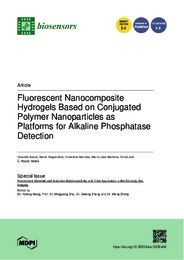Título :
Fluorescent Nanocomposite Hydrogels Based on Conjugated Polymer Nanoparticles as Platforms for Alkaline
Phosphatase Detection |
Autor :
Alacid Martínez, Yolanda Inmaculada 
Esquembre, Rocío 
Montilla, Francisco 
Martínez Tomé, María José
Mateo , C. Reyes |
Editor :
MDPI |
Departamento:
Departamentos de la UMH::Agroquímica y Medio Ambiente |
Fecha de publicación:
2023-03-20 |
URI :
https://hdl.handle.net/11000/30727 |
Resumen :
This work describes the development and characterization of fluorescent nanocomposite
hydrogels, with high swelling and absorption capacity, and prepared using a green protocol.
These fluorescent materials are obtained by incorporating, for the first time, polyfluorenes-based
nanoparticles with different emission bands—poly[9,9-dioctylfluorenyl-2,7-diyl] (PFO) and poly[(9,9-
di-n-octylfluorenyl-2,7-diyl)-alt-(1,4-benzo-{2,1,3}-thiadiazole)] (F8BT)—into a three-dimensional
polymeric network based on polyacrylamide. To this end, two strategies were explored: incorporation
of the nanoparticles during the polymerization process (in situ) and embedment after the
hydrogel formation (ex situ). The results show that the combination of PFO nanoparticles introduced
by the ex situ method provided materials with good storage stability, homogeneity and reproducibility
properties, allowing their preservation in the form of xerogel. The fluorescent nanocomposite
hydrogels have been tested as a transportable and user-friendly sensing platform. In particular,
the ability of these materials to specifically detect the enzyme alkaline phosphatase (ALP) has been
evaluated as a proof-of-concept. The sensor was able to quantify the presence of the enzyme in an
aqueous sample with a response time of 10 min and LOD of 21 nM. Given these results, we consider
that this device shows great potential for quantifying physiological ALP levels as well as enzyme
activity in environmental samples.
|
Palabras clave/Materias:
nanocomposite hydrogel
polyfluorene
fluorescent sensor
alkaline phosphatase
immobilization
portable device
enzyme |
Área de conocimiento :
CDU: Ciencias puras y naturales: Química |
Tipo de documento :
info:eu-repo/semantics/article |
Derechos de acceso:
info:eu-repo/semantics/openAccess
Attribution-NonCommercial-NoDerivatives 4.0 Internacional |
DOI :
https://doi.org/10.3390/bios13030408 |
Publicado en:
Biosensors 2023, 13, 408 |
Aparece en las colecciones:
Artículos Agroquímica y Medio Ambiente
|
 La licencia se describe como: Atribución-NonComercial-NoDerivada 4.0 Internacional.
La licencia se describe como: Atribución-NonComercial-NoDerivada 4.0 Internacional.
.png)
